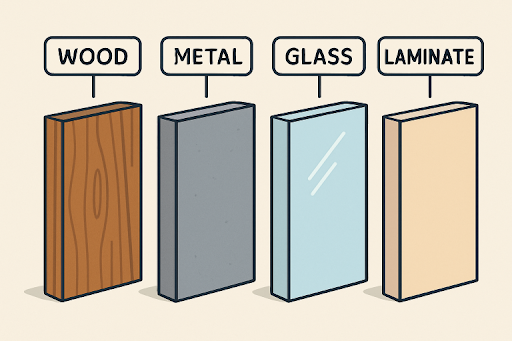Key Takeaways
- Office workstations must be built with durable materials and finishes to ensure longevity and functionality.
- Balancing aesthetics, maintenance, and environmental impact helps create an optimal workspace.
- Understanding the unique advantages and limitations of different materials guides smart purchasing decisions.
Introduction
Choosing the right materials and finishes for office environments is fundamental to creating spaces that prioritize durability, functionality, and visual appeal. A workstation reflects aesthetics and the productivity and comfort of its users. When investing in office workstations, businesses must assess how well the furnishings will withstand daily demands, maintain appearance, and support long-term value.
The array of available materials—from classic wood and robust metal to innovative synthetics and glass—offers options tailored to different workplace needs. Careful consideration of finish types, upkeep requirements, and environmental impacts makes a significant difference when outfitting a modern workplace.
Wood: Timeless Elegance and Strength
Wood remains a favored material for office furniture thanks to its classic aesthetic and enduring strength. Hardwoods such as oak, maple, and walnut are especially valued for their ability to withstand dents, scratches, and daily use without losing appeal. Wood surfaces can often be refinished or repaired, making them a sustainable long-term investment. However, they require periodic care—such as polishing or re-sealing—to protect from stains or moisture damage. Plywood and veneer options can provide visual warmth at a more accessible price point, but may be less resilient.
Wood furniture offers unmatched sophistication and tactile comfort for offices seeking both beauty and performance. As noted by architectural experts at Architectural Digest, wood workstations can elevate the look of workplaces and provide lasting usability with the right maintenance.
Metal: Modern and Resilient
Metal is a top choice for contemporary office workstations due to its strength, stability, and modern aesthetic. Steel frames and panels excel in high-traffic workplaces, offering inherent resistance to impact, moisture, fire, and pests. Powder-coated steel enhances longevity by further protecting surfaces from scratches and rust. For spaces requiring flexibility, aluminum presents a lightweight yet sturdy solution—ideal for furniture requiring frequent rearrangement, such as mobile desks or modular shelving.
Designs often combine metal with complementary materials such as wood or glass, blending visual interest with robust structural integrity. This hybrid approach enables offices to project a sophisticated image while ensuring day-to-day resilience
Laminate: Versatile and Cost-Effective
Laminate surfaces represent a practical, cost-effective alternative for outfitting workstations. Constructed by layering images or patterns onto durable substrates, high-pressure laminates mimic the appearance of expensive woods or stone at a lower cost. They resist scratches, stains, and fading, making them highly popular in busy or collaborative offices. Additionally, they’re easy to clean, and many finishes are available in modern, vibrant styles.
While laminate may not offer the tactile authenticity of real wood or stone, innovations in texture and finish now deliver remarkably realistic visuals. For offices on a budget, laminate solutions allow for maintaining a stylish, professional atmosphere without sacrificing practicality.
Glass: Sleek and Contemporary
Glass workstations add a touch of sleek, contemporary design to any environment. Tempered glass is preferred for work surfaces, thanks to its reinforced strength and resistance to scratches and thermal stress, ensuring safety even in intensive-use areas. Glass top desks and partitions open up the visual space, making them ideal for small or collaborative offices where transparency and natural light are priorities.
Specialty glass treatments—such as frosting or etching—can enhance privacy for sensitive tasks while preserving a modern appearance. Regular cleaning is essential to maintain their pristine look, particularly in public or client-facing spaces.
Plastic and Acrylic: Lightweight and Flexible
Modern offices increasingly embrace high-quality plastics and acrylics for their adaptability, affordability, and creative possibilities. Polypropylene and acrylic deliver rugged performance with minimal risk of chipping or staining, and they are available in a broad spectrum of colors and designs. These materials are a great fit for dynamic offices needing flexible work setups, temporary partitions, or easily repositionable furniture.
While plastic-based products may not always convey the premium appeal of wood or metal, advancements in manufacturing have greatly improved their durability and aesthetic range, making them suitable for innovative, fast-paced work environments.
Upholstery and Synthetics: Comfort and Style
Workstation seating is an area where material choice directly impacts employee comfort and health. Mesh, felt, and advanced synthetic fabrics provide breathable support, conform to users’ shapes, and are typically easy to maintain. Synthetic upholstery resists stains, offers color fastness, and enables easy cleaning, making it a smart choice for shared seating or high-use spaces.
Many office furniture manufacturers now prioritize non-toxic and hypoallergenic upholstery finishes, which improve indoor air quality and occupant wellness.
Sustainable Materials: Eco-Friendly Choices
Environmental factors are increasingly important when specifying office workstations. Sustainable materials such as reclaimed wood, bamboo, and recycled plastics provide durability with a smaller ecological footprint. These choices support corporate responsibility goals while contributing to healthier workplace environments and supporting long-term usability. As awareness of green design grows, furniture made with low-emission finishes and responsible sourcing is expected to remain a priority in commercial office planning.
Opting for eco-friendly materials signals a company’s commitment to quality and environmental stewardship, aligning the physical workspace with broader sustainability values.
Final Thoughts
Office workstations are the foundation for day-to-day productivity, comfort, and well-being. Selecting the best materials and finishes requires careful consideration of durability, design, maintenance ease, and sustainability. By understanding the strengths and limitations of each option, organizations can craft workspaces that are stylish, practical, and future-ready—helping employees thrive and leaving a lasting impression for years to come.




